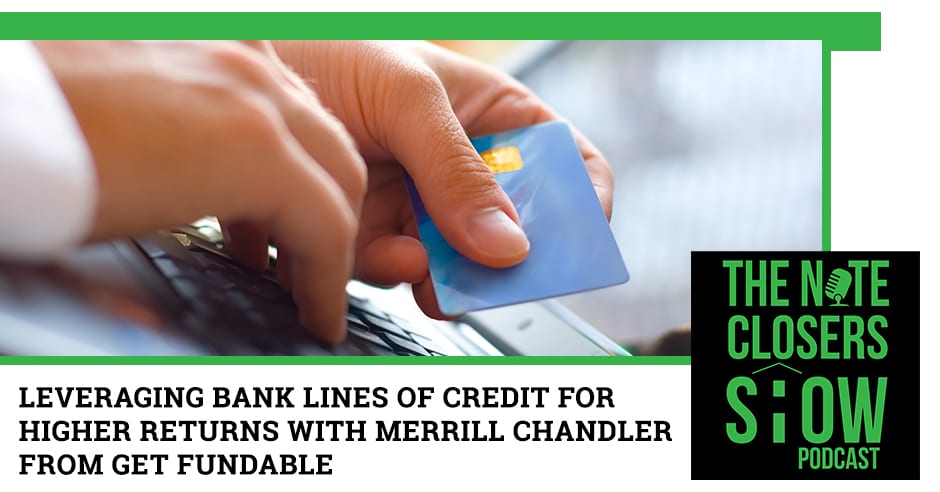
With all the crazy things happening right now, it is not anymore a surprise to find ourselves in a massive financial institution pivot. Yet, not many people are catching on. In this episode, Scott Carson is joined by our regular credit Messiah, Merrill Chandler from Get Fundable, to talk about how to leverage bank lines of credit for higher returns. Merrill shares how banks are working to offset their bad loans by adding new lines of credit and approving business loans for clients who are responsible lenders. They also discuss why FHA loans have higher default rates and why the banks get upset when commercial loans go above 70% LTV.
—
Watch the episode here
Listen to the podcast here
Leveraging Bank Lines Of Credit For Higher Returns With Merrill Chandler From Get Fundable
We’ve got our repeat guest, Merrill Chandler from Get Fundable join us. We’re going to talk about some great stuff that you want to take note. We’ll talk about what’s causing a lot of the defaults taking place out there in the market. How the banks are trying to book end their losses in the commercial side by giving new loans to business owners and the nice borrowers, not the naughty borrowers and then also some of the things that you can do with that capital, those lines of credit to leverage your return to infinite numbers as well.
—
As always, I’m excited to be here with you and even more jacked up to have Merrill Chandler from GetFundable.com and Get Fundable Podcast join us on the show. What is going on, Merrill?
I’ve been geeking out of all things lender policies. I know that’s a thrill for all of you. You’re like, “That sounds like a great way to spend a day.” For me, think of fundability as the engine. Fundability is the ability to get funding. I’m going to be sharing some stuff with you, but we’re in a massive financial institution pivot. There are good things going on and there are not so good things going on, but it’s a hard pivot. I’m studying so that I know how to apply these fundability issues to my clients, our students, even to people who are on the Get Fundable Facebook page, that are part of our group or what I call my tribe.
There are things people need to know that nobody is talking about. The lenders are pivoting behind our backs. Some of it is good, but not all of it. They’re pivoting on how banks need to show up in order to increase wallet share. If all the banks are competing for the same amount of your disposable income to pay for credit payments and some of it is cool, some of it is naughty. That’s what I’ve been studying and it’s been a fascinating thing. There’s this big push to take on Gen Z and Millennials and get them into banking. It’s as manipulative as it was back many years ago when they were driving all those free credit card offers to college students and say, “It’s free. Come and get it. We apply.” They don’t even know what debt is or debt management or things like that.
We’ve got what’s called Karina’s Law. There was a girl who didn’t know anything about debt. She committed suicide because she had $6,000 in debt. She was eighteen years old. She was depressed, didn’t know what to do, didn’t know what it meant. That seems nonsensical to most of us, but some people have no education whatsoever on what all this stuff means. She took her own life because she was so embarrassed. I talk about credit shaming. This girl was embarrassed to even talk to her parents about all of this debt that she took her own life. A big brouhaha started up and Congress implemented a statute that named after her where nobody under 21 can get a credit card or a credit instrument without parental or guardian support. There’s an article on here about how can Millennials and Gen Z power growth for financial institutions.
Their whole thing is young customers, how do we get in front of them? It’s taking a whole new level without the right framework that we are intentional borrowers. That we are focused in our borrowing and we’re strategic borrowers, but nobody even has this education. I’ve been on the war path to find out what lenders are doing so we can optimize and take the gifts they’re giving, the paydown schedules, the moratoriums, the things that they’re willing to do to support borrowers in this time versus 2008. What kind of shenanigans might some of them be looking at as well? That’s what I’ve been doing. What about you?
I have to comment on that because I was going through college many years ago and I can remember the fold-up tables. It was one of the biggest fundraising platforms for student organizations because you got paid $1 an application if somebody filled out.
Straight guaranteed approval.
Plus, the fact that they gave away all those t-shirts and water balls. That was the important thing. You wanted to have that college t-shirt. They outlawed that in the university and stuff like that. It was a great right lot of outlaw because it was predatory lending, “I’ll get the t-shirt, fill this out. I hope you do.”
The inquiries many years ago, people had little to know. Credit scores weren’t out publicly yet. They were still behind the scenes with the lender’s eyes only. Remember the days when you’re at the auto dealer say, “Can I see my credit score?” They say, “It’s illegal.”
“It’s my score. Why is it illegal if you pulled it there for you? You are charging me $25 credit pulling fee.” I remember being a mortgage broker and we weren’t supposed to show that. That was one of the big things, not just at the auto dealers, but also mortgage brokers a lot.
The whole point was, “How do we get people to pay for their own credit reports if our merchants are giving them out for free?” That’s what education.
There are a lot of different things going on with lenders and there’s a lot of stuff that’s coming back and biting the lenders in the butt. One of the biggest things that we’ve seen with the default rates climbing to 8.22% across the country, the biggest contributing factor to that default rate is your government FHA loans. They skyrocketed from 9.69% default rate in June 2020. July 2020, his numbers came out. That number went up 60% to the mid 50%. It’s under 16%.
FHA versus Fannie and Freddie this time.
I will say this because I had a mortgage banker that I was talking to at the Bank of America in 2019, donating the 3.5% down payments and paying $10,000 towards closing costs. People were getting in. It’s not a subprime loan, but it’s kind of a subprime.
If you’re wrapping in the money for the closing costs, it’s a higher amount for the loan. What do you think? I have ideas, but why is FHA leading the charge compared to Fannie and Freddie?
It wasn’t just Bank of America. I give them a hard case because they’re the bell cow when it comes to your regular day in-day out residential mortgage borrowers and people getting checking accounts. Over 5,500 branches across the country, they’re the biggest one. The reason why FHA is leading because if you’re getting as a borrower and this comes back with all the debt gain from many years ago, if you don’t have the 5% to put down, like your conventional mortgage companies were requiring you to do 5% or 10% down, you’re basically scratching together cash to get into a closing.
If you don’t pay the closing costs and you don’t have a down payment, you don’t have any investment. You don’t have any skin in the game to pay on time. No buffer for sure. A lot of times, as we’ve targeted these 40 cities is that $200,000 and below value in about every city across the country is where the high number of foreclosures is taking place. A couple exception is Miami Beach million-dollar condos was leading the way. There are hundreds and hundreds of grand in there.

Bank Lines Of Credit: Fundability is the engine to get funding.
They were way ahead of FHA backed loans.
That’s your first-time home buyer. They’re the ones that are working in the bars or restaurants. They’re in the service industry. They’re your $20 an hour employee that had been laid off, who are hurt the hardest for the most part. That’s my belief on why that’s leading the charge of the default rate.
I’ve been sharing this in my Get Fundable Facebook group, they’re scraping together or they’re not having to scrape anything. The closing costs and the down, everything is being comped by the loan. All of a sudden, they have the illusion that all systems go. It’s going to stay green lights. Nobody pretends that we’re going to have W or COVID is going to be a wave for 1.5 years and there’s no room. The first-time home buyers are the ones who are trying to get up and out of their rental environment. Rents are, by and large, more expensive than the mortgages are.
They’re trying to do right by themselves, but don’t have any room to do it where it’s like you say, Fannie and Freddie, that’s where I went. Fannie and Freddie, at least, you have to have savings. You have to have some cushion probably in the amount you’re putting down as well as the amount on a monthly basis because we only choose FHA for the first-time home buyers, etc. It’s seductive because we have these refi rates, even the purchase rates are near all-time lows. We’re approaching near zero more and more. How do you stop somebody who is not prepared for home ownership and what it means to do home ownership because they don’t know about homes? Their utilities might be included, their landscaping, whatever it is that they’re doing, they’re now personally responsible PI and TI. They don’t put all of that in play or they don’t think about it.
Let’s bring it back especially to the taxes and insurance. The insurance across the board is fine, but what you have seen blossoming up all across the country are those new build communities, buy in $500 down and the tax, especially as we saw happening as the COVID hit. What happened when you have a house that was a lot in 2019, that’s now a lot first property on here, your tax values go through the roof and that’s where you have a lot of defaults when you are first time home buyer. We look at the numbers and budget it. Not for the appreciation or the tax increase, which screws up a lot of escrow accounts and then that’s why you see a lot of March and April 2020 defaults across the country.
That’s a great observation because of that tax re-evaluation. Remember, assessors aren’t going to do their annual one if the appreciation rate is like this. They’re going to come back in six months or quarterly and add a new assessment because they want to capitalize their cities. The person who says, “I can afford $1,300 a month PITI,” and now insurance of PITI. Now, they’re getting obliterated. I call it taxation without representation when the Federal Housing Finance Agency Authority comes in and says, “These are amazing rates. Our countrymen do not deserve this level of rates. Let’s put in an artificial tax of 0.5% that the federal government doesn’t have to bail out Fannie and Freddie, FHA. They already had $22 billion in capital reserves.”
They come in and say, “It’s not going to harm anybody to pay 3.25% instead of 2.75%. Let’s put a tax on all refis.” To let all of our readers know, I’m going to take personal ownership of this, they pulled that back because I held a podcast and the next day, they lifted that tax. I must’ve been insanely influential unbeknownst to me. All kidding aside, they lifted that and said, “There are at least 60 days before they put that, December 1, 2020.” They’re holding it off. Which my poor friends who are mortgage brokers now, some people said, “I’m not saving much. I got a good deal last time with 0.5% premium, that’s not going to help me much.” As soon as they pulled that back off, my people are flooded. They are up to their desks and have 70 files high of people refinancing and trying to lock in these rates. I want to tell everybody, you’re welcome for getting another 90 days cut off of that. My personal influence was an important contribution there.
In Fannie and Freddie, they extended the forbearance agreements as we knew they were. They did the forbearance agreement out for another 5 to 6 months, because most of the state moratoriums ended in August 31, 2020 being the end date and foreclosures or evictions to start back up again. Minnesota delayed theirs until September 11, 2020, on Patriot’s Day. People are scared. Evictions are increasing.
There’s been a lot of back pressure to that because anything that’s put in artificially, we’ve got landlords are saying, “I have people who can pay, but you’re taking up my home.” The people are scared to death because they thought they would be employed after six months of COVID or did they come back? They’re not yet and they don’t want to be out on the streets. There’s this huge conflict. You’ve got the good guy, bad guy that every landlord is. All of us have that good guy, bad guy. They’re sitting here going, “I’ve been compassionate. I want to take care of you. I want to do my best. I’m not using my moratorium because my fundability coach told me not to.” I’m using my moratorium. I got to pay my bills. Literally, the shit is rolling downstream. Everybody is taking a hit in some way or another. This is crazy. Home prices in 30 markets are skyrocketing.
Realtors are out there and buying a home. It’s like, “The world is burning, but it’s a great time to buy a house.”
They’re playing their fiddles while the Nero blaze while Rome burns.
Here’s the thing I wanted to bring up too with you. Back in February 2020, I did an episode called The CMBS Meltdown, $50 billion loss. In January 17, 2020, they came out with an article as the banks filed their second quarter reports about what they’re looking at and then if you look at the big four banks. They’ve got over $150 billion at midyear forbearance agreement across the board, almost a record deferred of $32 billion for loan losses. The big kicker here is your local banks, especially the commercial side, finance 53% to 54% of the bad debt hidden their books, that’s small balance commercial stuff. Banks are looking to lend to offset those losses. I don’t want to say it’s a perfect storm. I would say it’s a perfect apocalypse.
If you’re going to have apocalypse, let them try and offset losses by giving small business loans. Our market, under $1 million, they’re doing it for their saving grace. You’re talking about some of these things, they’re saying the pivot right now is small business and personal. For some reason, they are celebrating sole proprietors because sole proprietor is an alter ego. They get to give a business loan to an individual. Good thing that we build our whole QFE. The Qualified Fundable Entity is a transparent fundable entity. We qualify, it’s spectacular, but lenders haven’t trained it. We’ve trained our borrowers how to be fundable, but banks are going sole proprietors because it’s a personal guarantee that isn’t even transparent. It’s to the person, but they get to put it on their business books.
The saving grace that they’re looking for, it’s like using a different pump to prime this one. They’re generating cash. All I know is in this quarter so far, my clients are at $5.3 million in funding over the previous quarter of $4 million. Pre-COVID, we average around $2 million to $2.5 million per quarter. We are at $5.3 million in two months of the third quarter. As we discussed in every one of your episodes, the outlying approvals are gone. When you’re a fundable borrower, when you’re at the bullseye, they’re going to give you money because every calculation and algorithm they have says, “This person is going to pay it back.”
If I’m going to bet on a dark horse, it’s going to be the bullseye borrower. That’s what we’ve been teaching everybody for years, but the point is now our people are killing it. We’re over twice what our normal non COVID funding are for clients and that’s good. $2.5 million to $3 million. Now we’re at 5 and 2 months, on this trajectory we’re going to hit $7 million to 8 million. In this quarter, that’ll be a best quarter ever for funding. These are business lines of credit, business credit card, business loans. The mortgages, they’re not the refis. They’re actual purchases. We’re screaming that COVID has been good to us because we have the answers of people finding us. They have a $20,000 limit. They got a $10,000 balance.
All of a sudden, it’s dropped to $10,500 is their limit. Their utilization goes up. Their score plummets, their fundability and now you’re in the toxic spiral where you cannot get more money because your utilization is so high and the lenders bring it on themselves. We even have strategies and scripts where we teach our clients how to pre-lowering of a limit. We teach our people how to negotiate what will serve the lender to protect the limit. So far, we’ve seen a substantial improvement in the number of people who are getting denials. Fundable borrowers are not getting any of their limits. The 24-month look back period has proven that these guys are legitimate borrowers and they’re safe borrowers. They’ll continue to get limit increases. I’m telling you, it’s a radical storm and an apocalyptic storm.
You have to look at a couple of things too because the banks have technically had a six-month window to see who’s on the naughty or on the nice list.
That’s one of the big coaching pieces that we’ve been doing. We had survived, thrived or recovered web class. We put that together. You know how much stuff I have in my head. Brett and I sat down and we built an eight-hour course where we were able to create this, “How to protect? How to thrive? How to talk to your lenders?” We had hundreds of people because we posted it on Facebook Live saying, “As soon as this thing is done, we’re taking it down, bundling it up and then we give it to our masterminders and clients.” We had hundreds of people watching because they’re like, “Where did this information come from?” As I told you before we started is how getting this out in front of people because there are actionable tips you can do to stop the madness and protect your limits, protect your fundability so that you continue to be fundable even right now.

Bank Lines Of Credit: If you’re going to have an apocalypse, banks try to offset losses by giving small business loans.
Here’s another thing we’ll throw in there and get people’s mind twisted because what we’ve seen across the board too is if you’re in a commercial space, commercial lenders, we said banks to finance 53% of the distressed commercial stuff, rent rates are down. Vacancy factors are down. When you look at how commercial property is valuated, you have reduced rents and reduce values. That means your cap rates drop right. When they find that traditional banks don’t want to finance higher than 69% LTV because they give a cushion. When you have values drop and you have rents drop, that means your value drops. That means the LTV that the banks are into doesn’t reduce, it goes up. Now, they’re sitting at 75% or 80% or 85%.
They don’t want to be in because that’s way pass their thresholds.
You may have performing borrowers that are performing defaults because the bank is going to go back to them like little Oliver Twist and say, “Can I have some more down payments? Can I have 5% or 10% of your cash to write down the loan, please?” Most of the property owners aren’t running reserves of 10% to 20%. If you’re going to get lines of credit or lines from banks on your commercial side, that’s a great opportunity because a lot of times the banks will finance this commercial property if you’re going to buy the debt. They don’t want to lose that $1 million balance or the $250,000 balance. They are often willing to carry that paper if you can take over the property and do something with it.
This is a commercial owner of Carrier Bank.
If it’s $1 million plus balance, a lot of times if you’ve got the team and you’re buying a bar or restaurant, “We’ll carry the paper for you as long as you bring some down payment or you’re at a good LTV.”
That is a strategy all by itself for use of funds. For the longest time, I’m talking a few years ago, I presumed the people would know what to do with their $300,000, $400,000, $500,000 or $1 million in credit lines business loans that we get them. I presumed that they would know what to do with them. We had a client tech training once a month. I give it to my adviser team, what are the consistent questions that come up that clients want to know? The most consistent question in June 2020 was, “What do we do with all this money?”
Some of them are looking at that that they were doing wholesaling and moving to fix and flipping, but flipping, when you have $600,000 in a Dallas marketplace, you’re like, “Is that the best use? I’m going to have to do 70 properties to use all of that money so they’re starting to look for other wealth strategies.” I’m like, “Do I have to teach you not just how to get the money, but now what to do with it?” The first time in years, I’m sharing with my clients other possibilities for use of funds.
I’ll show you a strategy too. This goes back to 2004, back to one of my first days in the note business. My mentor and a couple of guys that were all wealthy, three guys, all had roughly about $6 million on deposit at a bank. They all took their $6 million each and went to a bank and got a double line of credit. They’ve got $36 million line of credit on $18 million deposit.
That’s a real thing, especially in 2004.
They went out and bought a portfolio of debt at $0.25 on a dollar. That’s the thing is if you look at and leverage it right, you’ve got $200,000 as a line of credit. You could take that and put it as twenty down payments for $400,000 on your twenty properties or you could buy half of Cleveland. There’s a variety of things you can do. The thing is you’ve got to build it right. You’ve got to put the foundation in place. You’ve got to know what you can and can’t do.

Bank Lines Of Credit: There are actionable tips you can do to stop the madness and protect your limits and fundability so that you continue to be fundable even right now.
Every week, my clients, we meet on office hours. It’s where you meet with Professor Fundable and we sit down. The clients, we shoot the breeze. I’ve been doing this for a minute, but this was the first time a client had come to me with this. He goes, “What I’m wondering is, can I use a credit line to buy insurance premium on a Universal Life that then at a 10X factor and then borrow it for 1%?” I’m like, “Don’t let the word out, but you don’t want to use a credit line because they don’t want to carry a balance that along, but that’s what business loans are for. If you spend cold, hard cash at 3.5% right now, cold, hard cash and buy a premium on some of these insurance products and then they have a 10X factor. Now, you’ve got a $100,000 so now you’re sitting on $10 million in insurance policy that you then get to borrow back. That’s leveraging the leverage of the leverager.” I will talk about that in Advanced Strategies Class. I haven’t even put together all this offshore stuff, all of the advanced strategies.
Here’s the thing about building your lines of credit and having that capital business, you have the opportunities available for you. Whereas a lot of people don’t have the opportunities out there. When you can leverage that money or leverage it across the board, one of the things that we’ve tracked is how many people have IRAs across the country and the bigger markets. From all the investing we’ve done, we’ve worked with, we always said, “Investors average somewhere around $100,000.” What we found consistently in about every major city out there, if you take Salt Lake City where you’re at, and has 26,000 people that have an IRA account, 2/3 of most every city, the borrowers have at least $150,000 or more. Almost exact down to the decimal across more than $150,000 in an IRA account. That’s some stuff that you can leverage or other leveraging other people’s money that money’s making roughly 0% because it’s sitting in an account, not making anything less than 4%. Using your line of credit to find some great deals and leverage it by getting refinanced out with longer-term money. They’re looking to put their money to work.
Something is coming. FICO is pulling out their recession prep tools again. They did that in 2019. COVID hit, it was the unlikely source, but we have too many cross indicators. There are skyrocketing prices at the exact same time, even though it’s full dark, but too much is going on. The very first FinTech has been authorized by the Office of the Comptroller to be a federally chartered bank. These guys are bad asses at automatic underwriting. They’re using all the algorithmic tools and now they’re a chartered bank. They’re going to be coming in easily at a Tier 2 or Tier 3, which makes them a favorable instrument to use for clients and more people are going to follow suit. The future of banking is going to be radically different than what it looks like now.
This was one of the articles that I had done some research on. That same Gen Z and Gen X, they don’t like FinTechs. They’re suspicious of them. They like the big banks, but they hate branches. It’s all electronic. All their deposits, withdrawals, transfers, everything is electronic. Bank of America and Wells Fargo are huge with the Gen Z. That makes a fundability market for me because the top four banks are spectacular. Especially, if you’re a bullseye borrower and they’re in the mood to lend to you to make up for shortfalls in other areas of their portfolio. We live in some amazing times.
Another thing came out, there is a record amount of savings account being deposited that we haven’t seen in many years, as people are putting money into savings because of that. What the banks are doing with it, they’re leveraging that out in higher interest rate, credit cards, loans, lending, and other things where they’re giving you 0.1% and if they’re making 1%, that’s not an 0.9%. It’s a 900% return.
To all the readers, go to GetFundableBootcamp.com to see when our next boot camp is. Read the reviews. I get all misty eyed going, “That’s what you got from this? That’s awesome. I’m happy that’s what you got.” There’s a section in the Bootcamp where we talk about the bank rating system. They call it bank rating but it’s technically, depositor rating. However much money you have in there in factors of 1, 2, 4, 7 and then you add a zero for those, $20,000, $40,000, $70,000, all those numbers matter. You become more valuable as a depositor the second you have those in your accounts. They’re going to leverage the hell out of those savings accounts. For all of my life, it has been true that funds that are in checking accounts are more actionable for lenders than funds that are in savings account.
They’re more meaningful because they have different right. They can use the funds in the overnight to trading differently than savings. Savings have an FDIC pushback on it. What I want you to do is I want you to open up another checking account and put your savings into the checking account, not a savings account. You will become a more valuable borrower for that one move all by itself because the lender can do it. Your money’s still safe. It’s that you become more valuable as a borrower because that money in that bank account is more actionable than the savings account. If I could get to every one of those savings people and say, “Don’t put up a new checking.”
Check it out. Merrill goes through a ton of great information. This is a drop in the bucket of what you’d learn. GetFundableBootcamp.com, well worth it. Two best days that you’ll spend online live learning from the master and maestro of credit right here. Have you gotten the lab coat yet, Professor Fundable?
There is the Professor Fundable lab coat and I put it on now in certain sections when I’m geeking out. I put this on and so far, people have loved it. I love geeking out. I’m the geek, so you don’t have to. You get to make money and I’ll put money in your pocket.
Merrill, you guys be safe out there. Thanks for coming on to the show.
It was awesome to see you again.
One of the most valuable educational pieces that we have on the podcast and helping you capitalize and take advantage of what’s going on in the market out there so that you can go out and rock it. We’ll see you at the top. Peace.
Important Links:
- Get Fundable
- Get Fundable – Facebook
- The CMBS Meltdown – previous episode
- http://GetFundableBootcamp.com/
About Merrill Chandler
 My book: The New F* Word – Get your free copy at GetFundableBook.com
My book: The New F* Word – Get your free copy at GetFundableBook.com
My bootcamps: Check out GetFundableBootcamp.com
My podcast: Go to GetFundablePodcast.com
BIO
For over 25 years, Merrill Chandler, a co-founder of Lexington Law Firm, has been the pointy-edge-of-the-spear regarding the education of Borrowers in how to improve their borrowing opportunities and success.
During that time, Merrill developed a process to optimize personal and business credit profiles to improve a borrower’s “Fundability.” Based upon this concept, he founded GetFundable.com to deliver his revolutionary technology to entrepreneurs, business owners, and real estate investors who want easy, no-hassle, approvals.
In 2016, Merrill met with FICO CEO, Will Lansing, to review the impact GetFundable.com optimization technology was having on a borrower’s “fundability.” As a result of that meeting, Merrill was authorized to meet with FICO’s Score Development Teams. After signing a non-disclosure agreement, Merrill was able to quiz FICO developers about their credit profile metrics so that he could better assist borrowers in accomplishing their funding needs. Merrill and members of his team have been to every FICO World Conference since then with a commitment to continually improve Fundability Optimization and significantly improving Borrower’s funding approvals.
Love the show? Subscribe, rate, review, and share!

